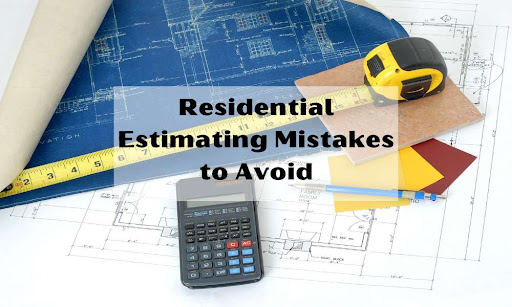
Building a new home is an exciting and rewarding experience, but it can also be a daunting task. From choosing a builder to selecting the right materials and finishes, there are many decisions to make along the way. One of the most critical aspects of the building process is estimating the cost of the project accurately. Unfortunately, many homeowners and builders make common mistakes that can lead to cost overruns, delays, and frustration. In this blog, we will discuss some of the most common residential estimating mistakes to avoid, so you can stay on budget and achieve the home of your dreams without unnecessary stress. Whether you’re a first-time builder or a seasoned professional, this information will help you plan your next residential construction project with confidence.
Overview of the mistake
One of the most common mistakes that individuals and businesses make is not accounting for all costs when making decisions. This mistake can lead to underestimating the true cost of a project or investment, which can ultimately result in financial loss or failure.
Examples of costs not typically accounted for
There are many costs that may not be accounted for when making a decision. Some examples include:
- Opportunity cost: The cost of the next best alternative foregone when a decision is made.
- Indirect costs: Costs that are not directly related to the production of goods or services, such as rent, utilities, and insurance.
- Externalities: The costs or benefits that are not reflected in the market price of a good or service, such as pollution.
- Time costs: The cost of the time and effort that is required to complete a task.
- Maintenance costs: The cost of maintaining equipment, infrastructure, or other assets.
Consequences of not accounting for all costs
Not accounting for all costs can have significant consequences. For example:
- Financial loss: If the true cost of a project or investment is underestimated, it may result in financial loss.
- Inefficient resource allocation: Not accounting for all costs can lead to inefficient resource allocation, as resources may be allocated to projects or investments that are not profitable.
- Environmental damage: Externalities that are not accounted for can lead to environmental damage, which can have long-term negative consequences.
- Poor decision-making: Not accounting for all costs can result in poor decision-making, as decision-makers may not have a complete understanding of the costs and benefits associated with a particular decision.
How to avoid this mistake
To avoid this mistake, it is important to take a comprehensive approach to decision-making. This involves identifying all costs associated with a project or investment, including indirect costs, externalities, and opportunity costs. It may also involve conducting a cost-benefit analysis to evaluate the potential costs and benefits of different options.
Additionally, it is important to regularly review and update cost estimates as new information becomes available. This can help to ensure that decision-makers have a complete understanding of the costs and benefits associated with a particular decision.
Overview of the mistake
Inaccurate takeoffs refer to a common mistake in the construction industry where a construction professional or estimator makes an error in calculating the amount of material or labor required for a particular project. This mistake can occur due to various reasons, such as inadequate data, errors in calculations, or incorrect assumptions.
Importance of accurate takeoffs
Accurate takeoffs are crucial in the construction industry as they provide the foundation for the entire project. A mistake in the takeoff process can lead to significant cost overruns, schedule delays, and other problems that can impact the project’s success. For example, if a takeoff is underestimated, the project may run out of materials or labor, leading to delays and additional costs. On the other hand, an overestimation can lead to unnecessary expenses and wasted resources.
Consequences of inaccurate takeoffs
The consequences of inaccurate takeoffs can be severe and far-reaching. Inaccurate takeoffs can cause project delays, cost overruns, and lower profit margins. These mistakes can also lead to rework, schedule changes, and legal disputes, all of which can negatively impact the project’s success. Additionally, inaccurate takeoffs can lead to a loss of credibility and reputation for construction professionals or firms, which can make it difficult to secure future projects.
How to avoid this mistake
There are several ways to avoid inaccurate takeoffs in construction projects. One of the most effective methods is to use advanced software and tools to automate the takeoff process. These tools can help improve accuracy and efficiency, reducing the risk of mistakes. Additionally, construction professionals can work to ensure that they have all the necessary data and information before starting the takeoff process. They should also double-check their calculations and assumptions to ensure accuracy. Finally, construction professionals can benefit from ongoing training and education to stay up-to-date on the latest tools, techniques, and best practices in the industry.
Failure to Account for Site-Specific Conditions
One common mistake made by construction professionals is failing to account for site-specific conditions when planning and executing a project. Site-specific conditions refer to unique environmental, geographical, or physical features of a site that can impact the construction process and project outcomes. Ignoring or overlooking these conditions can lead to significant project delays, cost overruns, and even safety hazards.
B. Examples of site-specific conditions to consider:
Site-specific conditions can vary greatly depending on the location and type of project. However, some common examples include:
- Soil and geology: The soil and rock composition of a site can significantly impact foundation design, excavation, and other construction activities. Soil with high clay content, for instance, can be prone to swelling and shrinkage, which can cause cracks in building foundations.
- Climate and weather: The local climate and weather patterns can impact everything from construction scheduling to material selection. Extreme temperatures, wind, rain, and snow can all pose challenges for workers and equipment.
- Environmental factors: Sites near wetlands, rivers, or other bodies of water may be subject to special environmental regulations that can impact project design and construction activities. Endangered species or protected habitats may also need to be considered.
- Access and logistics: Sites with limited access or challenging logistics, such as steep slopes, narrow roads, or congested urban areas, can make it difficult to transport equipment and materials to and from the site.
- Existing infrastructure: Projects that involve building or renovating existing structures may need to consider the condition and capacity of the existing infrastructure, such as electrical, plumbing, or HVAC systems.
C. Consequences of not accounting for site-specific conditions:
Failing to account for site-specific conditions can have a range of negative consequences, including:
- Delays and cost overruns: Unforeseen site conditions can cause delays in the construction schedule, which can lead to increased costs and missed deadlines.
- Safety hazards: Ignoring potential safety hazards, such as unstable soil or hazardous materials, can put workers and the public at risk.
- Structural issues: Failing to properly account for soil conditions, water tables, or other site-specific factors can result in structural issues, such as settling or shifting foundations.
- Environmental damage: Ignoring environmental regulations or failing to consider the impact of construction activities on the surrounding environment can result in damage to ecosystems and natural habitats.
D. How to avoid this mistake:
To avoid the mistake of failing to account for site-specific conditions, construction professionals should:
- Conduct a thorough site assessment: Before beginning a project, it’s important to conduct a thorough assessment of the site to identify any potential site-specific conditions that may impact the project.
- Engage with local authorities and experts: Consulting with local authorities and experts, such as geotechnical engineers or environmental consultants, can help identify potential issues and ensure compliance with local regulations.
- Incorporate site-specific conditions into project plans: Project plans and designs should incorporate site-specific conditions to ensure that the construction process and project outcomes are optimized for the specific site.
- Monitor and adapt to changing conditions: Site-specific conditions can change over time, so it’s important to monitor and adapt to any changes that may impact the project.
Conclusion
Estimating the cost of a residential project is an essential step in ensuring its success. However, many common mistakes can lead to inaccurate estimates and costly overruns. By avoiding the mistakes mentioned in this blog, such as underestimating material and labor costs, not factoring in project scope changes, and failing to account for local building codes and regulations, you can improve your accuracy and profitability.
It’s also important to use reliable estimating software, stay up-to-date with industry trends and pricing, and communicate clearly with clients and subcontractors. Remember that residential estimating is both an art and a science, and it takes practice and experience to get it right. By learning from your mistakes and continually improving your methods, you can increase your chances of success and establish a reputation as a reliable and efficient contractor.









